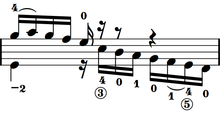Damping (music)
Damping is a technique in music for altering the sound of a musical instrument by reducing oscillations or vibrations. Damping methods are used for a number of instruments.


Guitar
On guitar, damping (also referred to as choking) is a technique where, shortly after playing the strings, the sound is reduced by pressing the right hand palm against the strings, right hand damping (including palm muting), or relaxing the left hand fingers' pressure on the strings, left hand damping (or left-hand muting). Scratching is where the strings are played while damped, i.e., the strings are damped before playing. The term presumably refers to the clunky sound produced. In funk music this is often done over a sixteenth note pattern with occasional sixteenths undamped.
Floating is the technique where a chord is sustained past a sixteenth note rather than that note being scratched, the term referring to the manner in which the right hand "floats" over the strings rather than continuing to scratch.
Skanking is when a note is isolated by left hand damping of the two strings adjacent to the fully fretted string, producing the desired note (the adjacent strings are scratched). The technique is especially popular among ska, rocksteady and reggae guitarists, who use it with virtually every riddim they play on.
Damping is possible on other string instruments by halting the vibration of the strings using the left hand, similar to on a guitar.[2]
Piano
When a piano key is pressed, the damper for that note is raised and a hammer strikes the string. Unless the sustain pedal is depressed, releasing the key allows the damper to return to place, damping the note.
Hammered dulcimers
While the keys on modern pianos control both the hammers and dampers, this is not possible with the hand-held hammers used to play some other members of the box zither family. Historical players such as Joseph Moskowitz sometimes used their coat sleeves as dampers, but pedal-operated dampers were one of the main distinguishing features of the concert cimbalom developed by Jószef Schunda in 1874 and are now often added to larger or more expensive American hammered dulcimers, Eastern European dulcimers, and Greek sandouris. They are rarely if ever found on the Romanian ţambal mic, the Iranian santur, or the Indian santoor
Gamelan
Damping is also important in most percussion instruments in the gamelan, including sarons, gendèrs, and gangsas. On instruments that are played with a single mallet, the left hand is used to damp the previously hit note when a new note is played. On the gendèr, which is played with mallets in both hands, the keys must be damped by the same hand.
See also
References
- Snyder, Jerry (1999). Jerry Snyder's Guitar School, p.28. ISBN 0-7390-0260-0.
- Bolton, Ross (1 June 2001). Funk Guitar: The Essential Guide. Private lessons (Musicians Institute). Hal Leonard Corporation. ISBN 978-0-634-01168-9. OCLC 48470650.
